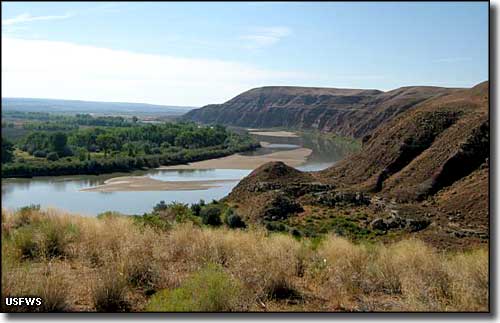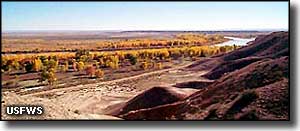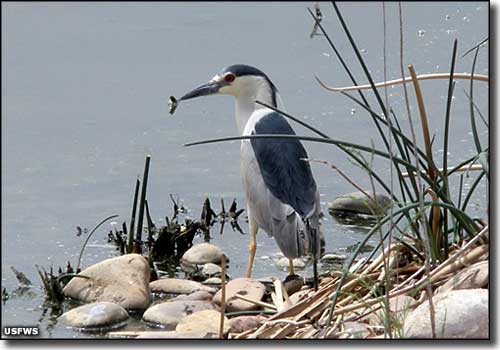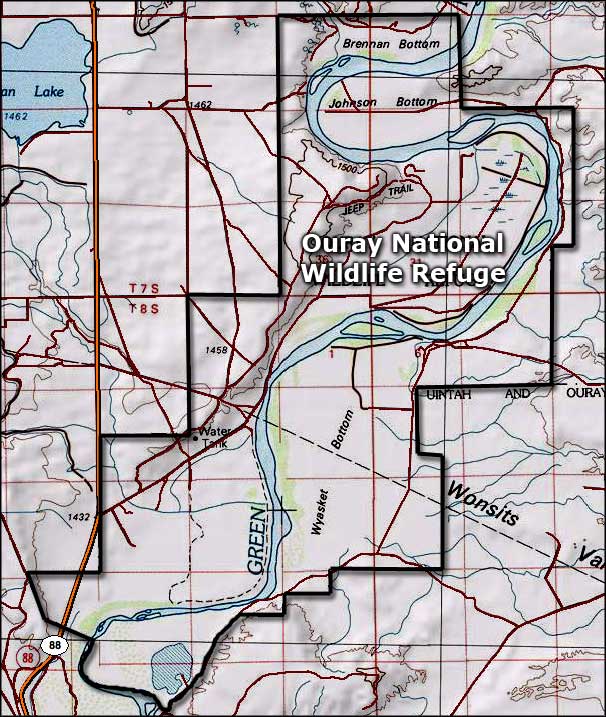
Ouray National Wildlife Refuge

The Green River flowing across Ouray National Wildlife Refuge

Located in the high desert of northeastern Utah, Ouray National Wildlife Refuge gets only about 7" of precipitation in a normal year. This refuge is in a location that includes some 12 miles along the Green River where the river is able to spread out and create an oasis in this otherwise dry and barren landscape. There's 11,987 acres of land inside the boundary of the NWR, but 3,800 of those acres are leased from the State of Utah and the Uintah and Ouray Indian Reservation. The Refuge occupies about 19 square miles of Green River bottomlands and water surface. The upper edge of the river valley is the upper edge of the bluffs, above which are the grasslands and shrubland that compose the rest of the Refuge. About 200 different species of birds have been documented at the Refuge, plus the usual mule deer, elk, prairie dogs, river otters and beavers in this lengthy riparian area of high cottonwoods, Russian olives and river willows.

This is an area that has seen massive invasion by foreign, noxious weeds plus selenium contamination from local mining residues. All of the habitat is in jeopardy but the US Fish & Wildlife Service is working to mitigate some of the worst effects through intensive water management, mowing, prescribed burning, the judicious use of chemicals and the reseeding of areas with native species of grasses and weeds.
Part of what made the Ouray National Wildlife Refuge necessary was the construction of the Flaming Gorge Dam upstream of the Refuge. While that reservoir was being filled, everything downstream suffered - especially the riparian habitats that millions of migrating birds needed as resting places on their long spring and fall journeys. So the same forces that helped create the Browns Park NWR in Colorado also made possible the creation of Ouray NWR in Utah. And recently, the management of the refuge has shifted from an aggressive, and thoroughly controlling, water retention program to a program that more closely mimics the natural forces and events in the surrounding countryside. This approach also helps to protect and maintain natural riparian areas downstream of the Refuge by maintaining historic levels of water flow in the river bottom.
To get there: about 14 miles west of Vernal on US Highway 40, go south on State Route 88 for 14 miles to the Ouray National Wildlife Refuge entrance. The Refuge headquarters is another mile down that road, past the entrance. The gates are open from 1 hour before sunrise to 1 hour after sunset. Except for times of bad weather, most Refuge roads are open to the public, unless otherwise signed.
Spring and fall, early morning and early evening are the best times to visit, but bring lots of mosquito repellent... Fair Warning! Nearest food, fuel and accommodations are 28 miles west in Roosevelt or 30 miles north in Vernal.
There's a 12-mile self-guided auto tour route that crosses through many of the different wildlife habitats at Ouray NWR. The wildlife viewing area next to the croplands is a spot where you can see thousands and thousands of ducks and geese during the spring and fall migrations. On the river you can go canoeing or rafting but you need to keep all motorized or mechanized vehicles on the designated roadways and parking areas. The Visitor Center has drinking water and restrooms. There's also restrooms next to the information kiosk near the Refuge entrance.

Black crowned night heron at Ouray National Wildlife Refuge

Ouray National Wildlife Refuge map
